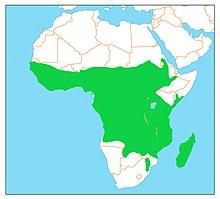| Broad-billed roller | |
|---|---|
 | |
_(11924782823)%2c_crop.jpg) | |
| Nominate race in Madagascar (above) E. g. suahelicus in South Africa (below) | |
| Scientific classification | |
| Kingdom: | Animalia |
| Phylum: | Chordata |
| Class: | Aves |
| Order: | Coraciiformes |
| Family: | Coraciidae |
| Genus: | Eurystomus |
| Species: | E. glaucurus |
| Binomial name | |
| Eurystomus glaucurus (Statius Muller, 1776) | |
 | |
native range | |
| Synonyms | |
| |
The broad-billed roller (Eurystomus glaucurus) is a member of the roller family of birds which breeds across tropical Africa and Madagascar in all but the driest regions. It is a wet season breeder, which migrates from the northern and southern areas of its range towards the moister equatorial belt in the dry season.
Taxonomy and systematics
The broad-billed roller was originally described in the genus Coracias. Formerly, some authorities have considered the broad-billed roller to have been a subspecies of the oriental dollarbird. Alternate names for the broad-billed roller include the African broad-billed roller and cinnamon roller.
Subspecies
Four subspecies are recognized:[2]
- E. g. aethiopicus Neumann, 1905, the Nile Valley broad-billed roller or Abyssinian broad-billed roller is found in Ethiopia
- E. g. afer (Latham, 1790), originally described as a separate species in the genus Coracias, is found from Senegambia to northern Democratic Republic of Congo and South Sudan
- E. g. suahelicus Neumann, 1905, the East African broad-billed roller, is found in from Somalia to Uganda, northern Zambia, Angola, Mozambique and north-eastern South Africa
- E. g. glaucurus (Statius Muller, 1776), the Madagascar roller or Madagascar broad-billed roller, breeds in Madagascar but ranges to mainland Africa in winter
Description
The broad-billed roller is 29–30 cm in length. It has a warm back and head, lilac foreneck and breast, with the rest of the plumage mainly brown. The broad bill is bright yellow. Sexes are similar, but the juvenile is a drabber version of the adult, with a pale breast. The broad-billed roller is striking in its strong direct flight, with the brilliant blues of the wings and tail contrasting with the brown back.
The call of the broad-billed roller is a snarling k-k-k-k-k-r-r-r-r-r sound.
Distribution and habitat
This is a species of open woodland with some tall trees, preferably near water. These rollers often perch prominently on trees, posts or overhead wires, like giant shrikes.
Behaviour and ecology
They are inactive for most of the day, apart from chasing intruders, but in late afternoon they hunt for the swarming ants and termites on which they feed, sometimes in groups of 100 or more rollers. They drink like swallows, dipping their bills into water in flight.
This bird nests in an unlined hole in a tree cavity, laying 2-3 eggs.
References
- ^ BirdLife International (2016). "Eurystomus glaucurus". IUCN Red List of Threatened Species. 2016: e.T22682912A92968062. doi:10.2305/IUCN.UK.2016-3.RLTS.T22682912A92968062.en.
- ^ "IOC World Bird List 7.1". IOC World Bird List Datasets. doi:10.14344/ioc.ml.7.1.
- Kingfishers, Bee-eaters and Rollers by Fry, Fry and Harris, ISBN 0-7136-8028-8
External links
- Broad-billed roller - Species text in The Atlas of Southern African Birds.
